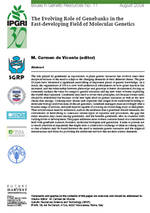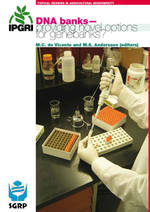Molecular genetics and DNA banks
 |
IPGRI Technical Bulletin No. 2: Molecular tools in plant genetic resources conservation: a guide to the technologies (0.2MB)
In October 1995, IPGRI organized a small workshop on the use of molecular techniques in the conservation of plant genetic resources. One area of discussion was the considerable range of different molecular techniques available and the ways in which they could best be used. Deciding on which technique would be most appropriate for particular investigations is not always straightforward and depends on a range of a different factors including the nature of the problem, the biology of the species and the resources available. A number of the experts who participated in the meeting collaborated with IPGRI staff to prepare this publication, which attempts to provide a brief overview of currently available techniques and to outline some of their strengths and limitations. It also provides a framework to assist users in identifying what technique(s) might be most appropriate for their own needs. It is not intended as a laboratory manual of the techniques or as a substitute for the many excellent discussions of the strengths and weaknesses of individual methods that can be found in the literature. Rather, it is a broad survey of the main features of the different techniques and of the factors that conservation workers should bear in mind when initiating a molecular genetic based investigation.
Authors: Karp, A.; Kresovich, S.; Bhat, K.V.; Ayad, W.G.; Hodgkin, T.
Publication Year: 1997
Pages: 47
ISBN-10: 92-9043-323-X
ISBN-13: 978-92-9043-323-1
Language: English
 |
IPGRI Technical Bulletin No. 10: Molecular markers for genebank management (1.6MB)
In the last decade, the use of DNA markers for the study of crop genetic diversity has become routine, and has revolutionized biology. Increasingly, techniques are being developed to more precisely, quickly and cheaply assess genetic variation. These techniques have changed the standard equipment of many labs, and most germplasm scientists are expected to be trained in DNA data generation and interpretation. The rapid growth of new techniques has stimulated this update of IPGRI's Technical Bulletin No. 2, "Molecular tools in plant genetic resources conservation: a guide to the technologies" (Karp et al. 1997b). Our goal is to update DNA techniques from this publication, to show examples of their applications, and to guide genebank researchers towards ways to maximize their use. This bulletin reviews basic qualities of molecular markers, their characteristics, the advantages and disadvantages of their applications, and analytical techniques, and provides some examples of their use.
There is no single molecular approach for many of the problems facing genebank managers, and many techniques complement each other. However, some techniques are clearly more appropriate than others for some specific applications. In an ideal situation, the most appropriate marker(s) can be chosen irrespective of time or funding constraints, but in other cases the choice of marker(s) will depend on constraints of equipment or funds. The purpose of this publication is to explain the characteristics of different markers and guide to their use through a number of real examples that represent well informed choices. What is most important is to choose a marker that can appropriately address well-defined questions through good experimental design, ideally leading to peer-reviewed scientific publications.
Experimental design has many definitions depending on the type of question being asked and on the field of science addressed. We use the term here in a very general way to cover all aspects of planning an experiment, including a clear definition of the question being addressed; knowledge of prior studies addressing the question; proper choice of molecular markers and of data used to address the question; knowledge of the characteristics, strengths and weaknesses of the data; sources of unexpected variation in the data; how much data are needed; proper methods to analyze the data; and limits to conclusions you can make from the results.
One of the most important considerations before beginning any experiment is to address proper experimental design. Improper experimental design can make the work inconclusive, misleading, insignificant, and most likely unpublishable. Similarly, improvements in experimental design can change an uninspired study to a highly significant one with little to no increase in time and funds. Poor experimental design can waste significant resources and damage the reputation and impact of your genebank.
It is beyond the scope of any publication to outline all possible pitfalls that can lead to poorly designed experiments, analyses or conclusions, and different considerations of proper experimental design need to be made in particular fields. This technical bulletin outlines some basic considerations regarding molecular marker types and analyses to lead the reader. There is no substitute, however, for basic knowledge of the biological questions being addressed, knowledge of the taxonomic group under consideration and a thorough literature review to ensure that similar work has not been done before. If limitations of any type hinder genebank and germplasm managers with regards to these factors, collaboration or consultation with experts is well worth the effort.
Excellent reviews of methodology and data interpretation are presented in Weising et al. (1995), Hillis et al. (1996), Staub et al. (1996), Hillis (1997), Karp et al. (1997a,b) and Avise (2004). Hamrick and Godt (1997) present a review of isozyme data; Doebley (1992), Clegg (1993b) and Spooner and Lara-Cabrera (2001) present a review of molecular data for plant genetic resources and crop evolution; Bruford and Wayne (1993), Wang et al. (1994), Gupta et al. (1996), Powell et al. (1996a) and Weising et al. (1998) of microsatellite data; Wolfe and Liston (1998) on Polymerase Chain Reaction (PCR) related data. Schlötterer (2004) reviews the history and relative utility of different molecular marker types. Sytsma and Hahn (1997) present reviews of molecular studies in crop and non-crop plants. Some information from Spooner and Lara-Cabrera (2001) for crop diversity studies was used and updated; Spooner et al. (2003) was used for taxonomy studies.
An overview of the main marker techniques and their comparative qualities is presented in the section titled, "Overview of molecular technologies". Applications of molecular techniques in genebank management and crop breeding are the subject of the following sections. The section titled, "Future challenges" focuses on the current developments in molecular marker applications and future challenges that could result from these developments. Elements of experimental design are discussed throughout and some basic aspects of data analysis are discussed in "Genebank management".
Authors: Spooner, D.; van Treuren, R.; de Vicente, M.C.
Publication Year: 2005
Pages: 126
ISBN-10: 92-9043-684-0
ISBN-13: 978-92-9043-684-3
Language: English
 |
Issues in Genetic Resources No. 11, August 2004: The Evolving Role of Genebanks in the Fast-developing Field of Molecular Genetics (0.5MB)
The role played by genebanks as repositories of plant genetic resources has evolved since their inception because of the need to adapt to the changing demands of their different clients. The past 20 years have witnessed a significant unravelling of important pieces of genetic knowledge. As a result, the organization of DNA is now well understood, information on how genes function has increased, and the relationship between phenotype and genotype is better documented, forcing us constantly readjust the value we assign to genetic resources and tap new ways of better exploiting the wealth they represent. Genebanks may need to revise their principles, not because former tasks should be abandoned but because of the new light shed on genetic resources as well as the new clients that emerge. Contemporary clients seek expertise that ranges from traditional breeding to molecular biology and even state-of-the-art genomics. Genebank managers must accordingly offer a broader range of services, and staff must be capable of covering an overarching array of disciplines. Thus several issues must be addressed, such as the attributes that a genebank should maintain, the convenience of networking to outsource certain types of expertise and procedures, the gap this entire situation may create among genebanks, and the benefi ts genebanks offer in countries with varying levels of development. This paper addresses most of these concerns based on a consultation held with genebank curators, breeders, molecular biologists and geneticists. It aims to present not so much solutions as arguments that might steer a constructive exchange of ideas in coming years, so that a balance may be found between the need to maintain genetic resources and the required infrastructure and those for providing the additional services that modern science demands.
Author: Carmen de Vicente, M. (ed.)
Publication Year: 2004
Pages: 54
ISBN-10: 92-9043-623-9
ISBN-13: 978-92-9043-623-2
Language: English
 |
DNA banks - providing novel options for genebanks? (0.8MB)
The rapidly expanding study of DNA in so many areas of science has created an odd surplus: the DNA itself. Reasonably easy and inexpensive to store, with established techniques for almost infinite multiplication, the samples of DNA created in laboratories around the world have almost by accident become an important resource for future research. Participants at an IPGRI-organized meeting on The Evolving Role of Genebanks in the Fast-Developing Field of Molecular Genetics (see de Vicente MC, editor. The Evolving Role of Genebanks in the Fast-developing Field of Molecular Genetics. Issues in Genetic Resources No. 11. IPGRI, Rome, Italy; 2004) discussed informally how a more organized and collaborative approach to DNA banking might benefit the conservation and use of genetic resources and other areas of research. Those discussions prompted IPGRI to undertake a worldwide survey, which in turn resulted in this book.
As will be seen from the individual chapters, DNA banking is not at present widespread (fewer than 20% of the institutions responding to a survey bank DNA) but would be welcomed (more than half of the respondents expressed interest in banking DNA). The book also presents considerable evidence of the ways in which DNA banking, by permitting relatively easy transfer and analysis of genetic material, can improve genebank management, plant breeding, conservation, population studies, and many other subjects. Taken together, these suggest that there is indeed a need for practitioners to cooperate to develop the kind of collaborative system envisaged in this book.
Many issues remain to be sorted out. Some are extremely practical: how should DNA banks be physically arranged and should they store both DNA and the tissues from which it was extracted? How should DNA samples be distributed? Others hinge on technical issues: what are the best bioinformatic methods to tie together the various strands of information and the DNA samples from which the information was derived? Yet others involve high-level policy decisions: what rules and procedures will govern the exchange of DNA samples and sequence information, and how will access and benefit sharing, including the benefits of further research on the samples, be governed? By pulling together so many individual experiences and perspectives this book sets out several signposts that will help to guide further discussion and elaboration of DNA banking.
It should be stressed that none of the contributors sees DNA banking as a substitute for the conservation of genetic resources. DNA banks complement conservation strategies that make use of ex situ and in situ conservation, and they can help to ensure the optimal use of plant and animal populations. DNA banks are probably not going to permit the resurrection of extinct populations. But their potential to enhance so many aspects of the use and conservation of genetic resources makes them an important topic for further discussion and elaboration, to which we hope this book will make a useful and distinct contribution.
Authors: de Vicente, M.C.; Andersson, M.S. (eds.)
Publication Year: 2006
Pages: 84
ISBN-10: 92-9043-702-2
ISBN-13: 978-92-9043-702-4
Language: English
Comments
- No comments found





Leave your comments
Post comment as a guest